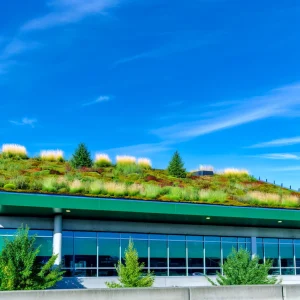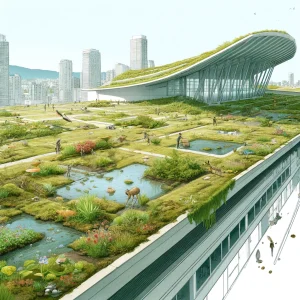Green roofs have become a key solution in making urban environments more sustainable and livable, particularly in places like British Columbia. This region, known for its lush landscapes and dedication to environmental preservation, is witnessing an uptick in green roof adoption on commercial buildings. These installations do more than just boost the aesthetic value of urban structures; they bring many environmental, economic, and social benefits. We will look into the merits of green roofs, clear up some widespread misunderstandings, and provide insights into their implementation and upkeep.

The Merits of Green Roofs
On the Environment
Green makes a substantial positive contribution to the environment. Green roofs are instrumental in managing rainwater in British Columbia, where climates range from dry summers to wet winters. They absorb rain, cutting down runoff and easing the strain on urban sewage systems during heavy rainfall. The living roof at the Vancouver Convention Centre, which captures rainwater and supports wildlife, exemplifies the diverse environmental advantages of green roofs.
Economically and Socially
Green roofs offer natural insulation, leading to savings on heating and cooling expenses. They shield roofing materials from the elements, thereby prolonging their lifespan. Green roofs also increase property values and create peaceful green areas for employees and visitors, boosting overall health and productivity.

Dispelling Misconceptions
Regarding Maintenance and Durability
Many believe green roofs require high maintenance and offer less durability than traditional. Yet, with the right installation, green roofs are quite resilient and durable. They demand regular upkeep similar to garden care, which, while necessary, is far from cumbersome. Optimal maintenance can be achieved with minimal effort through seasonal care, appropriate irrigation, and choosing native plant species.
About Structural Issues
There’s a common apprehension about the additional weight and potential structural problems. However, with today’s engineering and design advancements, it’s feasible to install green roofs on various buildings safely. It’s crucial to undertake a comprehensive evaluation and engage with professionals, but most commercial buildings can support a green roof with proper preparation.

Implementing Green Roofs
Starting Out
Embarking on a green roof project begins with a feasibility study examining roof size, load-bearing capacity, and sunlight availability. Based on these considerations, it’s critical to choose the right type of green roof (extensive, intensive, or semi-intensive).
Upkeep Necessities
After installation, maintaining a healthy green is vital. This involves consistent weeding, fertilizing, and pruning and maintaining effective drainage and irrigation systems. Opting for native plants can lessen the need for watering and simplify maintenance in British Columbia’s climate, as these species are well-suited to the local environment.
Far from being a mere trend, green roofs represent a lasting solution to the environmental challenges urban areas face, especially in British Columbia. Understanding and addressing common misconceptions, coupled with careful planning and maintenance, allows commercial buildings to leverage the extensive benefits of green roofs. These installations contribute to a healthier planet, bring economic benefits, and improve urban community well-being. The outlook for urban landscapes is bright, with green roofs set to play a crucial role in this greener future.
